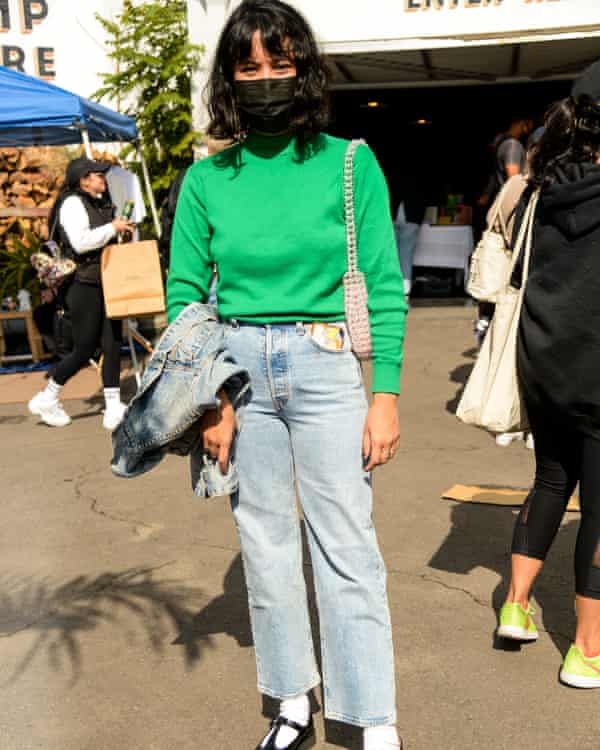Out of Thi World Fashion Theme
L ast twelvemonth, many people got many things wrong nigh how the pandemic might alter our lives. No, cities did non die; yes, people however blow out birthday candles and risk spreading their germs. Simply few 2020 forecasts missed their mark so spectacularly as the oftentimes-repeated claim that, equally the world reopened, we'd return to it in sweatpants.
If whatsoever single event crystallizes this misfire, it's last month'southward announcement that the direct-to-consumer loungewear make Entireworld was going out of concern. The company had been a breakout darling of 2020, its cheerfully hued cotton wool basics poised at the fortuitous intersection of "cute plenty for Zoom" and "cozy enough to work, sleep, and recreate from bed in, for the bulk of a calendar year". News outlets, meanwhile, pointed to Entireworld's astonishing 662% increment in sales last March not as a right-identify, right-time one-off, but an indication of our collective sartorial destiny.

"[T]he sweatpant has supplanted the blue jean in the pants-wearing American imagination," alleged GQ last April. The New York Times Magazine followed suit a few months later with an Entireworld proper noun-check in its August 2020 cover story, headlined "Sweatpants Forever".
But it wasn't to be. Instead, as 2021 brought forth the world's reopening, I noticed a style sensibility that seemed to defy final twelvemonth's housebound pragmatism. From Instagram to the streets of my New York City neighborhood, the people were turning looks. Kooky looks, to be precise, from platform Crocs to strong-shouldered silhouettes. My online window shopping exploits turned upward scores of sundry garments, across brands, all in the same exuberant hue of 90s DayGlo green. From sensible underpants to faux fur–trimmed tops, I subconsciously catalogued the color labels assigned to each ("celery", "gross dark-green", "slime").
This new, psychedelic palette seemed like a spiritual difference from Trump-era minimalism and its many shades of biscuit. Less dutiful, more than winking.
Sweatpants seem destined for a mere supporting office.
Jessica Richards, a trend forecasting consultant based in New York City, agrees that the pandemic has changed the manner nosotros dress. "Information technology'south actually for the better," she says – and in more ways than one.

It'due south no coincidence that the styles of the Great Re-entry reflect a certain giddiness, says Dr Jaehee Jung, a University of Delaware fashion studies professor who researches the psychology of fashion and consumer behavior. "The fact that there are more than opportunities to present ourselves to others makes us excited about the clothes we wear," Jung tells me.
"I'thousand definitely seeing people taking more than risks, in terms of color choices, prints and patterns, even shapes and silhouettes that they wouldn't accept worn before," says Sydney Mintle, a fashion industry publicist in Seattle. "People are like, 'life is short, vesture yellow.'"

Tamar Miller, CEO of the women'southward luxury footwear make Bells & Becks, has seen this mode risk-taking impulse first-hand in her company'due south recent sales. "My absolute, number-1, kind of off-the-charts shoe is one I did not expect," she says.
That shoe, per Miller'due south description, is a pointed-toe loafer in blackness-and-white snakeskin leather, topped past a prominent decorative tab with hardware detailing. It's a assuming selection, and 1 that affirms the demographic breadth of the desire to make a statement. Miller's target customers are not members of Gen Z, but rather their parents and grandparents.
Secondhand clothing – and its promise of luxe-for-less – has also plant its time to polish.
2020 was a banner year for the online resale market. Digital consignment platforms like Depop, ThredUp, and Poshmark swelled with the sartorial discards of an estimated 52.six meg people in 2020, 36.ii 1000000 of whom were selling for the first time, co-ordinate to a survey past ThredUp. A majority of millennial and Gen Z consumers indicated that they plan to spend more on secondhand dress in the next five years than in any other retail category, a sentiment expressed past 42% of consumers overall.
It's a phenomenon that may too exist contributing to the moment's ethos of mix-and-match experimentation. "Gone are the days of sleek, edited 'sheathing wardrobes', and in their identify are drawers overstuffed with vintage treasures sourced from Poshmark or Depop," writes Isabel Slone in a contempo Harper'south Bazaar article headlined "How Gen Z Killed Bones Blackness".
This doesn't necessarily mean that fast way is on its mode out. ("Some of those brands are doing big business organisation, and the numbers don't prevarication," Mintle sighs.) But the boom reflects, and may take helped accelerate, a growing departure from trend-chasing and disposable, low-cost wares. Y'all might even say that reflexive participation in fads is and so 2019 – not to the lowest degree because the US is struggling with supply chain bottlenecks equally nosotros enter the holiday season.
But our Roaring Twenties may be on the horizon. For 2022, Richards anticipates sparkle, novelty, "shoes that go 'clunk'" and "really maximalist styling". She didn't mention sweatpants.


0 Response to "Out of Thi World Fashion Theme"
Post a Comment